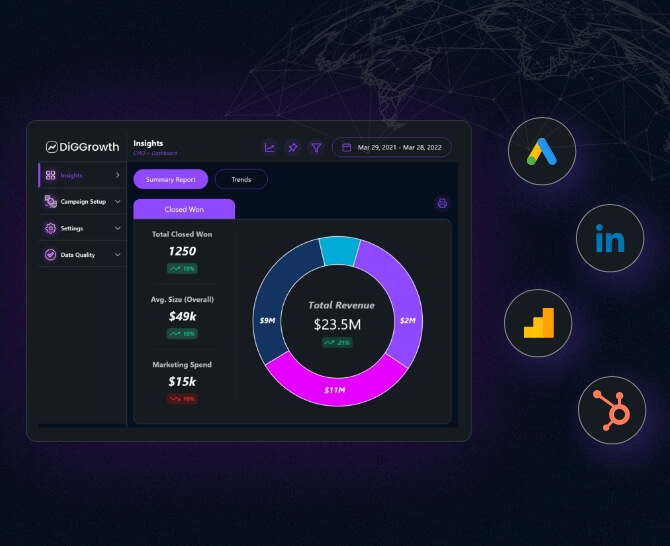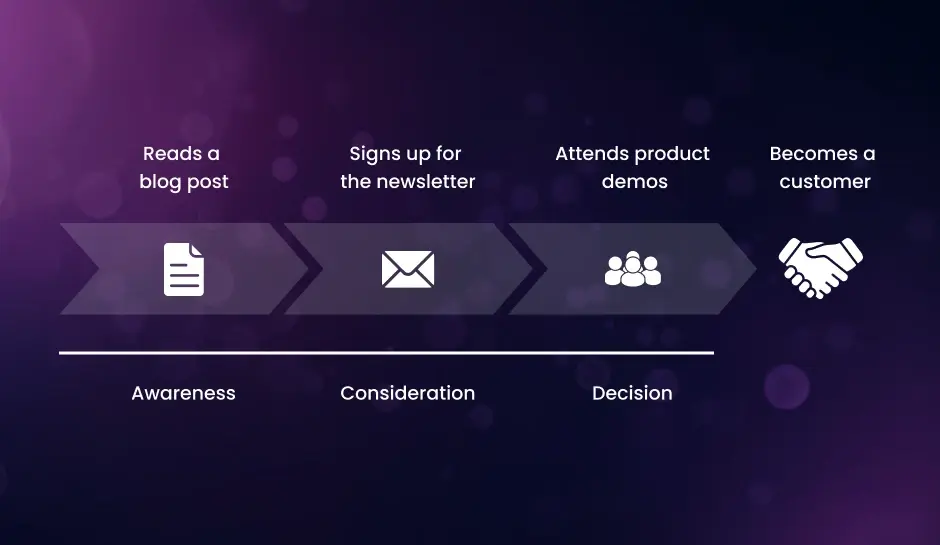
How Can SMBs Build a Successful Marketing Analytics Program?
With the right marketing analytics program, SMBs can gain valuable insights into their marketing efforts and make data-driven decisions that can help them improve their performance. In this blog post, we'll discuss how SMBs can build a successful marketing analytics progra
Small and medium-sized businesses (SMBs) often struggle to compete with larger companies when it comes to marketing.
These challenges include limited resources, a lack of expertise in marketing analytics, and difficulty in measuring and optimizing marketing efforts. In order to overcome these obstacles and achieve success, SMBs must prioritize building a strong marketing analytics program.
A successful marketing analytics program can help SMBs make data-driven decisions, optimize marketing strategies, and achieve greater ROI from their marketing spend. So, let’s explore how you can build a successful marketing analytics program for your SMB.
Understanding Marketing Analytics
Marketing analytics is the process of collecting, analyzing, and interpreting data from various marketing channels to measure and improve marketing performance. It tracks your website traffic, social media engagement, and other metrics that show you how well your marketing efforts are performing. Marketing analytics involves several key components, including data collection, analysis, and visualization.
There are different types of marketing analytics – descriptive, predictive, and prescriptive. Descriptive analytics involves looking at past data to understand what happened in the past, while predictive analytics uses statistical models and machine learning to predict what might happen in the future. Prescriptive analytics takes things a step further by recommending specific actions to improve future outcomes.
6 Steps to Build a Successful Marketing Analytics Program
With the right marketing analytics program, SMBs can gain valuable insights into their marketing efforts and make data-driven decisions that can help them improve their performance. Here’s how you can build a successful marketing analytics program:
1. Define Your Goals and Objectives:
Setting marketing goals and objectives helps you stay on track and measure your progress and is crucial to building a successful marketing analytics program.
SMBs should align their marketing analytics goals with their overall business goals. For example, if the business goal is to increase revenue, the marketing analytics goal could be to improve lead quality and conversion rates.
Examples of marketing goals and objectives include increasing website traffic, improving lead quality, reducing cost per acquisition, and increasing social media engagement. It’s important to make sure that these goals are specific, measurable, achievable, relevant, and time-bound (SMART).
2. Identify Your Key Metrics:
Marketing metrics and KPIs are critical to measuring and optimizing marketing performance. Examples of marketing metrics and KPIs include website traffic, conversion rate, customer acquisition cost, and return on investment (ROI).
And identifying your key metrics is essential to building a successful marketing analytics program. By monitoring these metrics, you can identify which marketing channels are most effective and make data-driven decisions to optimize your marketing efforts.
3. Collect and Analyze Data:
Once you’ve set your goals, it’s time to collect and analyze your data. The better your data quality and accuracy, the more reliable your marketing analytics program will be. By analyzing your data, you can gain insights into your marketing performance and make informed decisions about where to focus your efforts.
To collect data for marketing analytics, SMBs can use a variety of tools and sources, including social media platforms, email campaigns, website traffic, and customer relationship management (CRM) systems. It’s important to ensure that the data collected is accurate, consistent, and relevant to the marketing goals and objectives.
Analyzing data involves using statistical and data visualization tools to gain insights into marketing performance. Regression analysis can help determine the relationship between two variables, while A/B testing can help identify the most effective marketing strategies. Cohort analysis can help SMBs understand the behavior of specific customer segments over time.
4. Create Custom Dashboards:
When you want to streamline and derive insights from your unified marketing analytics data, a marketing dashboard is a sure-shot bet as opposed to digging through spreadsheets or opening up a sea of apps/platforms to check out different metrics.
Dashboards are a popular way to present marketing data in a user-friendly format that allows you to monitor key metrics in real-time. When creating visualizations, it’s important to choose the right format for your data and to avoid clutter and unnecessary complexity.
And custom dashboards can help SMBs visualize their marketing data in a way that is easy to understand. Dashboards can provide a quick snapshot of key metrics and trends, making it easier to identify areas for improvement. Many marketing analytics tools allow you to create custom dashboards, or you can use tools like Tableau or Power BI to create your own.
5. Leverage Data Analysis and Visualization:
Data alone isn’t enough. By creating visualizations such as charts, graphs, and dashboards, you can communicate your findings more effectively and identify areas of improvement. Once you have collected and organized your data, the next step is to analyze it and gain insights into your marketing performance.
This involves using statistical and data visualization tools to identify patterns, trends, and correlations in the data. Data analysis techniques can range from simple calculations such as averages and percentages to more complex methods such as regression analysis, A/B testing, and cohort analysis.
By analyzing your data in different ways, you can uncover hidden insights that can help you optimize your marketing strategy. Data visualization is also a critical component of marketing analytics.
It involves presenting data in a clear and concise manner using charts, graphs, infographics, and other visual aids. This helps to make complex data more easily understandable and allows you to communicate your findings more effectively to stakeholders.
6. Optimize Your Marketing Strategy:
The ultimate goal of marketing analytics is to turn data insights into actionable strategies and tactics that can help you optimize your marketing performance. By experimenting with different marketing techniques and continually refining your approach, you can identify areas of improvement and see what works best.
There are many different optimization techniques that SMBs can use to improve their marketing performance. Some of the most common include search engine optimization (SEO), email marketing, and retargeting. By testing and experimenting with different techniques, you can identify what works best for your business and refine your approach over time.
One of the most important aspects of optimization is to focus on continuous testing and experimentation. By constantly monitoring your metrics, trying new strategies, and evaluating your results, you can continually improve your marketing performance and drive growth for your business.
Data in Marketing Analytics
Data plays a crucial role in marketing analytics programs. By analyzing and interpreting data, marketers can make informed decisions and develop effective strategies to improve their marketing efforts. In this section, we will explore the role of data in marketing analytics, the types of data used, and the techniques for data collection and management.
Role of data in marketing analytics programs
Data is the foundation of marketing analytics programs. It provides marketers with valuable insights into customer behavior, preferences, and trends. By analyzing data, marketers can identify patterns, segment their target audience, and personalize their marketing campaigns. Data also helps in assessing the success of marketing initiatives and making data-driven decisions.
Types of data used in marketing analytics
There are various types of data used in marketing analytics programs. These include:
- Customer data
- Behavioral data
- Social media data
- Market data
This includes demographic information, purchase history, website interactions, and customer feedback.
This type of data includes information on how customers interact with marketing channels, such as click-through rates, conversions, and engagement metrics.
Social media platforms generate vast amounts of data, including customer sentiment, likes, shares, comments, and social interactions.
Market data helps marketers understand industry trends, competitor analysis, and market opportunities.
Data collection and management techniques
In order to effectively utilize data in marketing analytics programs, it is important to employ data collection and management techniques. These techniques involve:
- Data gathering
- Data cleaning
- Data analysis
- Data visualization
- Data security
This involves collecting data from various sources, such as CRM systems, website analytics tools, surveys, and social media platforms.
Data cleaning ensures that the data is accurate, complete, and free from errors or inconsistencies. This process involves removing duplicates, correcting typos, and resolving data discrepancies.
Data analysis involves using statistical methods and analytical tools to extract insights, identify patterns, and derive meaningful conclusions from the data.
Data visualization techniques, such as charts, graphs, and dashboards, help in presenting data in a visually appealing and easily understandable format.
Protecting data privacy and ensuring data security is crucial. Implementing proper data security measures and adhering to data protection regulations is essential in marketing analytics programs.
Analytics in Marketing
Marketing analytics involves the use of advanced techniques and methodologies to analyze and interpret data in order to make informed marketing decisions. It plays a crucial role in understanding consumer behavior, optimizing marketing strategies, and driving business growth.
Overview of marketing analytics techniques and methodologies
Marketing analytics utilizes various techniques and methodologies to collect, analyze, and interpret data. These may include:
- Predictive modeling
- Segmentation analysis
- Attribution analysis
- A/B testing
Predicting future consumer behavior and identifying potential customers
Dividing the target market into distinct groups based on demographics, behavior, or preferences
Determining the impact of each marketing channel on consumer conversions
Customer lifetime value analysis: Calculating the value of a customer over their entire relationship with the company
Experimenting with different marketing strategies to identify the most effective approach
Statistical analysis and data visualization in marketing analytics
Statistical analysis is a key component of marketing analytics. It involves using statistical techniques to analyze and interpret data, identify patterns and trends, and draw meaningful insights. Data visualization, on the other hand, helps present complex data in a visual format that is easy to understand and interpret.
By using statistical analysis and data visualization in marketing analytics, organizations can gain valuable insights into consumer behavior, market trends, and the effectiveness of their marketing campaigns.
Role of analytics in making data-driven decisions
Analytics plays a crucial role in making data-driven decisions in marketing. By analyzing and interpreting data, marketing professionals can make informed decisions about target demographics, marketing channels, campaign optimization, and overall marketing strategy.
Marketing analytics helps businesses identify opportunities, optimize marketing efforts, and allocate resources more effectively. It enables organizations to track and measure the impact of their marketing activities, identify areas for improvement, and make data-driven decisions to drive growth and success.
Skills for Marketing Analytics Professionals
Marketing analytics professionals need a combination of essential skills, technical skills, and soft skills to excel in their roles.
Essential skills for marketing analytics roles
- Statistical analysis
- Data management
- Problem-solving
- Critical thinking
- Data visualization
- Data modeling
- Database querying
- Data mining
A strong background in statistics is crucial for interpreting data and drawing meaningful insights.
Proficiency in organizing, cleaning, and manipulating large datasets is essential for effectively analyzing marketing data.
Marketing analytics professionals need to be skilled in identifying and solving complex business problems using data-driven strategies.
The ability to think analytically and critically is necessary for understanding the nuances of marketing data and making informed decisions.
Technical skills required for data analysis and modeling
Proficiency in using data visualization tools such as Tableau or Power BI to create impactful visual representations of data.
Knowledge of statistical modeling techniques and the ability to build predictive models using tools like R or Python.
Skill in working with SQL to retrieve and manipulate data from relational databases.
Understanding and applying data mining techniques to extract valuable insights from large datasets.
Soft skills needed for effective communication and collaboration
- Communication:
- Collaboration
- Business acumen
- Time management
Strong verbal and written communication skills are essential for effectively presenting data-driven insights to stakeholders and team members.
The ability to work collaboratively with cross-functional teams, such as marketers and data scientists, is crucial for successful marketing analytics projects.
A solid understanding of business objectives and strategies is important for aligning marketing analytics initiatives with overall organizational goals.
The ability to prioritize tasks and manage time efficiently is essential for meeting project deadlines and delivering high-quality results.
Conclusion
Building a successful marketing analytics program can be challenging for SMBs, but the benefits are well worth the effort. By collecting and analyzing data, visualizing insights, and taking action to optimize your marketing performance, you can improve your ROI, attract more customers, and drive growth for your business.
Remember that marketing analytics is an iterative process, and there is always room for improvement. By continuously testing and experimenting with new strategies and techniques, you can refine your approach over time and stay ahead of the competition.
If you’re ready to take your marketing to the next level, now is the time to start building your own marketing analytics program. With the right tools, resources, and mindset, you can harness the power of data to drive success for your SMB. Take the next step towards becoming a marketing analytics professional and join us in harnessing the power of data!
Wish to Set Up a Successful Marketing Analytics Program? Let’s Talk!
Our marketing science experts would love to help. Feel free to write to us at info@diggrowwth.com and we’ll get back to you.
Ready to get started?
Increase your marketing ROI by 30% with custom dashboards & reports that present a clear picture of marketing effectiveness
Start Free Trial
Experience Premium Marketing Analytics At Budget-Friendly Pricing.

Learn how you can accurately measure return on marketing investment.
Additional Resources
The Future of Marketing: How Predictive Lead and Account Scoring is Changing the Game
Can we, in this incredible marketing landscape driven...
Read full post postCloud Wars: A Comparative Analysis of Leading Cloud Vendors
How many companies are using cloud computing? Around...
Read full post postContent Marketing Attribution: Tracking Content Impact Across the Customer Journey
So, you've poured your heart into crafting the...
Read full post postFrequently Asked Questions
Marketing analytics is the process of collecting, analyzing, and interpreting data from various marketing channels to measure and improve marketing performance. It involves tracking metrics such as website traffic, social media engagement, and other key performance indicators to understand the effectiveness of marketing efforts.
There are three main types of marketing analytics:
Descriptive Analytics: This type involves looking at past data to understand what happened in the past. It provides insights into historical marketing performance and helps identify trends and patterns.
Predictive Analytics: Predictive analytics uses statistical models and machine learning algorithms to predict future outcomes based on historical data. It helps forecast customer behavior, campaign success, and other future marketing events.
Prescriptive Analytics: Prescriptive analytics goes beyond descriptive and predictive analytics by recommending specific actions to improve future outcomes. It provides actionable insights and helps optimize marketing strategies.
Here are six steps to build a successful marketing analytics program for SMBs:
Define Your Goals and Objectives: Align marketing analytics goals with overall business goals and ensure they are specific, measurable, achievable, relevant, and time-bound (SMART).
Identify Key Metrics: Determine the marketing metrics and key performance indicators (KPIs) that are most relevant to your business objectives, such as website traffic, conversion rate, customer acquisition cost, and ROI.
Collect and Analyze Data: Collect data from various marketing channels, ensuring its accuracy and relevance. Analyze the data using statistical and data visualization tools to gain insights into marketing performance.
Create Custom Dashboards: Use marketing analytics tools or platforms like Tableau or Power BI to create custom dashboards that present key metrics and trends in a user-friendly format.
Leverage Data Analysis and Visualization: Apply statistical techniques and data visualization methods to identify patterns, trends, and correlations in the data. Use visual aids like charts and graphs to communicate findings effectively.
Optimize Your Marketing Strategy: Turn data insights into actionable strategies and tactics by continuously testing and refining your marketing approach. Experiment with different techniques and optimize based on results to drive growth.
Data analysis and visualization are crucial in marketing analytics for several reasons. Data analysis helps uncover patterns, trends, and correlations in marketing data, providing valuable insights for decision-making. Visualization, through charts, graphs, and infographics, makes complex data more easily understandable and facilitates effective communication of findings to stakeholders.
SMBs can employ various optimization techniques to improve their marketing performance, including:
Search Engine Optimization (SEO): Enhance website visibility in search engine results to attract organic traffic.
Email Marketing: Develop targeted and personalized email campaigns to engage and convert leads.
Retargeting: Display relevant ads to users who have previously shown interest in your products or services.
Continuous testing, experimentation, and evaluation of results are key to refining marketing strategies and driving growth for SMBs.
 Manreet Khara
Manreet Khara 

